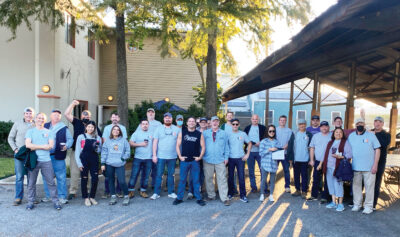The bad weather early this year did not dampen demand for Hardwood finished goods. In fact, the U.S. housing market is performing well, boosting demand for Hardwood products. There was a strike going on at the Port of Montreal at the time of this writing with container ships struggling to reach ports, and trucking shortages have slowed imported Hardwood lumber and finished goods from reaching customers. All the while, the regionally important species, Hard Maple, remains very popular with consumers. Demand is outpacing availability, resulting in ongoing price inflation. Prices have advanced for green 4/4 through 8/4 No. 1 Common and Better for FAS and Select and for No. 1 Common in both color designations. Prices for unselected thicknesses are reported to also have risen. Soft Maple also continues to show strong interest on markets, with supplies lagging demand. Some are using this species as a substitute for Hard Maple and Birch which are in very high demand.
With the rising demand and the low supply of Hardwoods, everyone was struggling to buy more lumber to meet their customers’ needs. Logs are now flowing better to sawmills, even though it is reported that sawmill output has not increased a great deal. With the pandemic restrictions still in effect across the province, some are in need of skilled workers, and staying afloat is a daily challenge. This has been noticed in softwood lumber and panel products industries as well, causing these products to be at record price levels.
Demand is strong for Ash from wholesalers and end users. Exports to China are good as is the domestic market. With warmer temperatures, Basswood is now being sawn due to risk of stain, so timing is important. Contacts noted markets like the shutter and window blind manufacturers, as well as mouldings and millwork, are readily absorbing the supply.
Cherry sales are reported as brisk by sawmills and to remanufacturers. Domestic and overseas demand is growing faster than its production, and so prices are rising. Demand is very strong for Hickory from the U.S., the Far East and Mexico. With the strong U.S. housing market, Hickory is being used for flooring, with more interest coming from moulding, millwork and cabinet manufacturers. The end users are finding it hard to source enough Hickory to meet their needs for finished goods, as is the case for wholesalers.
Flooring manufacturers are ramping up their White Oak amid supply strains. Sawmill production of this species was still relatively low as recently as April, so flooring manufacturers struggled with lumber purchases. Some wholesalers were also looking to increase their Red and White Oak supplies. Exports of Red Oak to China are noted as strong, good in the U.S., and decent in several international markets. Green Red Oak demand is vibrant, with prices pushing up for this species.
White Oak is reported as having robust demand but there are low supplies with fierce competition for logs, which are going mostly to veneer manufacturers, stave plants, overseas, and some to sawmills. Prices are, therefore, escalating and some at highest rates they’ve ever been.
Poplar is moving well on the domestic and international fronts. This is due to strong demand, limited supply, and high prices for other species that are often substituted for Poplar, including softwoods. Prices for this species continue to climb.
Walnut is in demand, especially for the upper grades, although all grades are faring well. Due to lack of supply some businesses are losing orders. Prices are trending upwards for this species.
Sawmill operators report brisk pallet cant and lumber sales. Pallet plants are undersupplied with raw materials, both Hardwoods and softwoods. Higher prices are being paid in hopes of replenishing on hand supplies.
The Quebec Minister of Finance, Eric Girard, tabled his budget this spring. His budget continues to support workers who lost their jobs and entrepreneurs hit hard by restriction measures due to the pandemic. The Minister stated that “With the arrival of vaccines, we can now look to the future with cautious optimism. We are able to return to the challenging and stimulating path that will take Quebec to the next step. This budget is for a resilient Quebec that is confident in its future.”
The budget provides for nearly $15 billion in additional initiatives by 2025-2026, including $5.2 billion starting this year to strengthen their health care system; support educational success and young people; accelerate growth and the transition to the new economy to increase productivity and stimulate business investment, which includes encouraging businesses to adopt new technologies to increase their productivity; and enhancing the investment and innovation tax credit, and reducing the tax rate for small and medium businesses; and support Quebecers. It contains an additional $7 billion to overcome the public health crisis.
It also includes creating wealth through innovation – $133 million to invest in infrastructure and research centers and $56 million to support innovation in strategic sectors; supporting the requalification of workers and getting them back into the labor market; continuing to support businesses affected by the pandemic; maintain the Concerted Temporary Action Program for Businesses (PACTE) and the Emergency Assistance Program for Small and Medium-Sized Businesses (PAUPME); extending the tax credit in respect of employer contributions to the Health Services Fund for employees on paid leave; and developing its economy in a sustainable way by implementing supporting measures for a sustainable economic recovery and support Quebecers.
According to the report, the economy restart has begun, and a strong economic recovery is expected in the coming years. A return to pre-pandemic levels of economic activity is anticipated by the end of 2021.
The Budget also expects a return to fiscal balance within seven years (2027-2028.) The plan to return to fiscal balance was based on these principles: the government’s commitment not to increase the tax burden; expenditure growth in line with revenue growth; the acceleration of economic growth; and an increased federal contribution to health costs.






